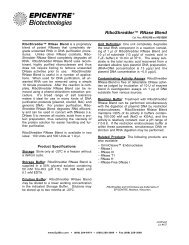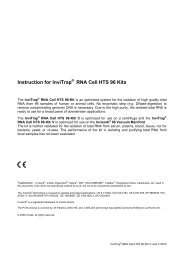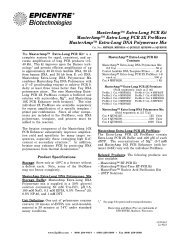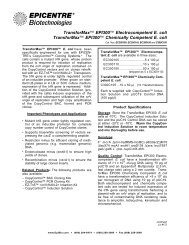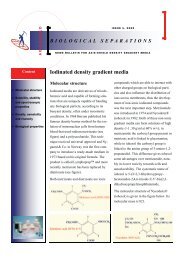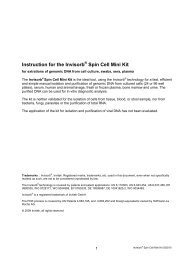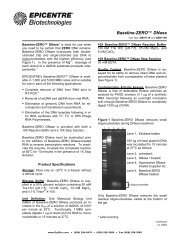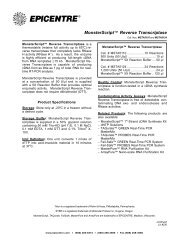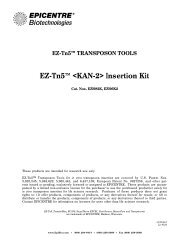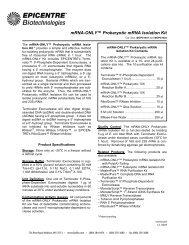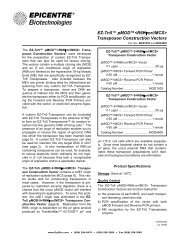OptiPrep™ The ideal density gradient medium for the purification of ...
OptiPrep™ The ideal density gradient medium for the purification of ...
OptiPrep™ The ideal density gradient medium for the purification of ...
- No tags were found...
You also want an ePaper? Increase the reach of your titles
YUMPU automatically turns print PDFs into web optimized ePapers that Google loves.
BIOLOGICAL SEPARATIONSPage 2Isolation <strong>of</strong> plasma membrane <strong>for</strong>m cardiac muscle by flotationUsing iodixanol <strong>gradient</strong>s, isolation <strong>of</strong> a plasma membrane(PM) fraction is <strong>of</strong>ten achieved simultaneouslywith <strong>the</strong> <strong>purification</strong> <strong>of</strong> o<strong>the</strong>r subcellular membranes.Most <strong>of</strong> <strong>the</strong>se methods are suitable <strong>for</strong> work with culturedcells and s<strong>of</strong>t tissues such as liver but tissues suchas muscle <strong>of</strong>ten require a customized method. Never<strong>the</strong>lesssome <strong>of</strong> <strong>the</strong> o<strong>the</strong>r iodixanol <strong>gradient</strong>s may be adaptableto muscle tissue.Research into cardiac muscle function <strong>of</strong>ten involves <strong>the</strong>complex intracellular processes by which <strong>the</strong> GLUT4glucose transport protein is translocated to and from <strong>the</strong>plasma membrane (sarcolemma). Thus in fractionations<strong>of</strong> cardiac muscle, a prime requirement is to be able resolve<strong>the</strong> plasma membrane from GLUT-4 transportvesicles and o<strong>the</strong>r membrane compartments. <strong>The</strong> overallstrategy <strong>of</strong> this flotation <strong>gradient</strong> protocol is thus similarto that using a cultured cell line but <strong>the</strong> details <strong>of</strong> <strong>the</strong>technique are ra<strong>the</strong>r different.<strong>The</strong> PM is usually <strong>the</strong> least dense <strong>of</strong> all <strong>the</strong> subcellularmembranes and our application highlights a novel exploitation<strong>of</strong> this property. In this protocol, a crudeplasma membrane suspension is adjusted to a <strong>density</strong>(1.049 g/ml, equivalent to 5% w/v iodixanol) justgreater than that <strong>of</strong> <strong>the</strong> plasma membrane <strong>of</strong> cardiacmuscle, thus during <strong>the</strong> centrifugation <strong>the</strong> plasma membranewill float to <strong>the</strong> top <strong>the</strong> liquid. By layering <strong>the</strong>sample upon a small cushion <strong>of</strong> 15% (w/v) iodixanol(1.103 g/ml) and centrifuging <strong>for</strong> 16 h, a shallow <strong>gradient</strong>will <strong>for</strong>m due to diffusion <strong>of</strong> iodixanol and also tosome sedimentation <strong>of</strong> iodixanol molecules close to <strong>the</strong>bottom <strong>of</strong> <strong>the</strong> tube. This will <strong>the</strong>re<strong>for</strong>e allow not onlyisolation <strong>of</strong> <strong>the</strong> plasma membrane, but also partial fractionation<strong>of</strong> some <strong>of</strong> <strong>the</strong> denser membrane compartments.Flotation <strong>of</strong>ten provides better recovery and/or resolution<strong>of</strong> <strong>the</strong> least dense components <strong>of</strong> a crude fractionthan does sedimentation. Overloading <strong>the</strong> <strong>gradient</strong>(instability <strong>of</strong> <strong>the</strong> sample/<strong>gradient</strong> interface) cannot occurin a flotation <strong>for</strong>mat. <strong>The</strong> particular <strong>for</strong>mat describedin this protocol also allows <strong>the</strong> sample to becontained within a relatively large volume; this alsominimizes interactions between particles in <strong>the</strong> <strong>gradient</strong>.For detailed protocols and references see S27 on <strong>the</strong>OptiPrep Application CD or online at: www.axisshield-<strong>density</strong>-<strong>gradient</strong>-media.comIsolation <strong>of</strong> plasma membrane using a continuous <strong>gradient</strong>Although both continuous and discontinuous iodixanol<strong>gradient</strong>s, centrifuged <strong>for</strong> 1-3 h have been used <strong>for</strong> <strong>the</strong>isolation <strong>of</strong> a plasma membrane (PM) fraction, <strong>of</strong>tensimultaneously with <strong>the</strong> <strong>purification</strong> <strong>of</strong> o<strong>the</strong>r subcellularmembranes, <strong>the</strong>re is evidence that resolution is <strong>of</strong>tenimproved by centrifugation <strong>for</strong> longer periods, since it isonly under <strong>the</strong>se conditions that true equilibrium <strong>density</strong>banding is achieved. In this method two strategies, employing<strong>the</strong> longer centrifugation time <strong>for</strong>mat are presented.Dunphy et al and Woods et al applied <strong>the</strong> postnuclearfraction to a continuous iodixanol <strong>gradient</strong>,while Bivona et al initially used a discontinuous sucrose<strong>gradient</strong> to provide a crude plasma membrane be<strong>for</strong>eloading on to <strong>the</strong> continuous iodixanol <strong>gradient</strong>.Generally <strong>the</strong> most successful <strong>gradient</strong>s <strong>for</strong> <strong>purification</strong><strong>of</strong> <strong>the</strong> PM cover a lower <strong>density</strong> range than do thoseprimarily aimed at resolving <strong>the</strong> Golgi and endoplasmicreticulum (ER) but because <strong>the</strong> <strong>density</strong> <strong>of</strong> <strong>the</strong> plasmamembrane (and o<strong>the</strong>r compartments) varies with <strong>the</strong>cell or tissue source, customized <strong>gradient</strong>s may coverei<strong>the</strong>r a broader and/or higher <strong>density</strong> range. <strong>The</strong>re ishowever ano<strong>the</strong>r consideration in selection <strong>of</strong> <strong>the</strong><strong>density</strong> range <strong>of</strong> <strong>the</strong> iodixanol <strong>gradient</strong>. Because Bivonaet al used a fraction containing principally PM and ER,<strong>the</strong>y were able to use a shallow low-<strong>density</strong> <strong>gradient</strong>




